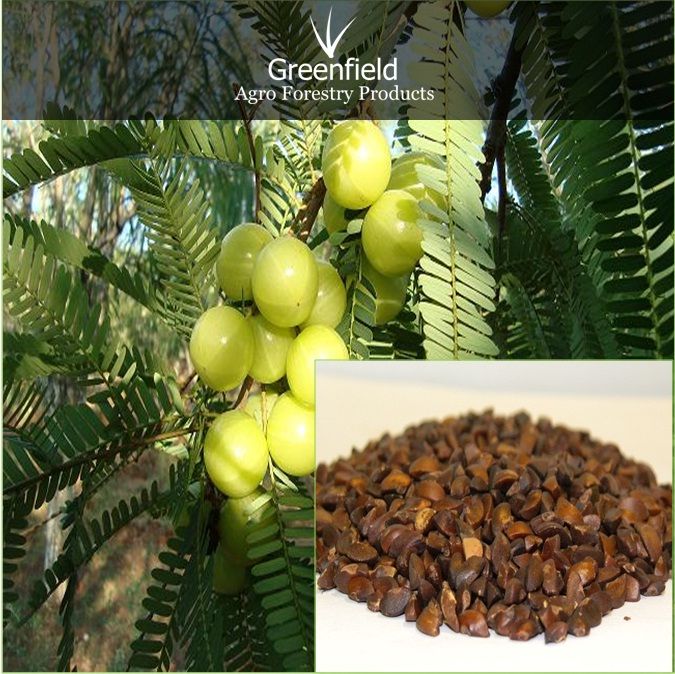

Precio FOB
Obtener el precio más reciente|
- Minimum Order
País:
India
N º de Modelo:
-
Precio FOB:
Lugar de origen:
-
Precio de pedido mínimo:
-
Cantidad de pedido mínimo:
-
Detalle de embalaje:
-
El tiempo de entrega:
-
Capacidad de suministro:
-
Tipo de pago:
-
Grupo de productos :
-
Persona de contacto Mr. Kunal
Sanjeevani Nagar, Shahi naka road, Jabalpur, Madhya Pradesh
Scientific Name: Emblica officinalis
Shape: Quarter Spherical
Color: light yellow
Usage: Germination (not for oil extraction)
Age: Fresh(less than a year, good for germination)
Origin: India
Packing: 5, *0,*0,*5,*0 (P/P)
Availability: Throughout the year
Category:- Fruit Seed
Quick Detail :
English Name : Indian gooseberryPhyllanthus emblica (syn. Emblica officinalis), the Nepalese/Indian gooseberry, or aamla from Sanskrit amalika, is a deciduous tree of the family Phyllanthaceae. It is known for its edible fruit of the same name.
USES:
Medicinal useIn traditional Indian medicine, dried and fresh fruits of the plant are used. All parts of the plant are used in various Ayurvedic/Unani medicine (Jawarish amla) herbal preparations, including the fruit, seed, leaves, root, bark and flowers. According to Ayurveda, aamla fruit is sour (amla) and astringent (kashaya) in taste (rasa), with sweet (madhura), bitter (tikta) and pungent (katu) secondary tastes (anurasas). Its qualities (gunas) are light (laghu) and dry (ruksha), the postdigestive effect (vipaka) is sweet (madhura), and its energy (virya) is cooling (shita).
According to Ayurveda, aamla balances all three doshas. While aamla is unusual in that it contains five out of the six tastes recognized by Ayurved, it is most important to recognize the effects of the “virya”, or potency, and “vipaka”, or post-digestive effect. Considered in this light, aamla is particularly helpful in reducing pitta due to its cooling energy. and balances both Pitta and vata by virtue of its sweet taste. The kapha is balanced primarily due to its drying action. It may be used as a rasayana (rejuvenative) to promote longevity, and traditionally to enhance digestion (dipanapachana), treat constipation (anuloma), reduce fever (jvaraghna), purify the blood (raktaprasadana), reduce cough (kasahara), alleviate asthma (svasahara), strengthen the heart (hrdaya), benefit the eyes (chakshushya), stimulate hair growth (romasanjana), enliven the body (jivaniya), and enhance intellect (medhya)
In Ayurvedic polyherbal formulations, Indian gooseberry is a common constituent, and most notably is the primary ingredient in an ancient herbal rasayana called Chyawanprash. This formula, which contains *3 herbal ingredients as well as clarified butter, sesame oil, sugar cane juice, and honey, was first mentioned in the Charaka Samhita as a premier rejuvenative compound.
In Chinese traditional therapy, this fruit is called yuganzi , which is used to cure throat inflammation.
Emblica officinalis tea may ameliorate diabetic neuropathy. In rats it significantly reduced blood glucose, food intake, water intake and urine output in diabetic rats compared with the non†diabetic control group.
Culinary useParticularly in South India, the fruit is pickled with salt, oil, and spices. Aamla is eaten raw or cooked into various dishes. In Andhra Pradesh, tender varieties are used to prepare dal (a lentil preparation), and amle ka murabbah, a sweet dish indigenous to the northern part of India (wherein the berries are soaked in sugar syrup for a long time till they are imparted the sweet flavor); it is traditionally consumed after meals.
Other usesPopularly used in inks, shampoos and hair oils, the high tannin content of Indian gooseberry fruit serves as a mordant for fixing dyes in fabrics. Amla shampoos and hair oil are traditionally believed to nourish the hair and scalp and prevent premature grey hair.
Medicinal Uses :
Fruit : Cooling, refrigerant, diuretic and laxative. Sharbat of amla with lemon juice taken for arresting acute bacillary dysentery.Related Product:
1.Anola Seeds,
2.Sitaphal Seeds,
3.Guava Seeds,
4.Bael Seeds,
5.Vilayati Imli Seeds,
| País: | India |
| N º de Modelo: | - |
| Precio FOB: | Obtener el precio más reciente |
| Lugar de origen: | - |
| Precio de pedido mínimo: | - |
| Cantidad de pedido mínimo: | - |
| Detalle de embalaje: | - |
| El tiempo de entrega: | - |
| Capacidad de suministro: | - |
| Tipo de pago: | - |
| Grupo de productos : | - |